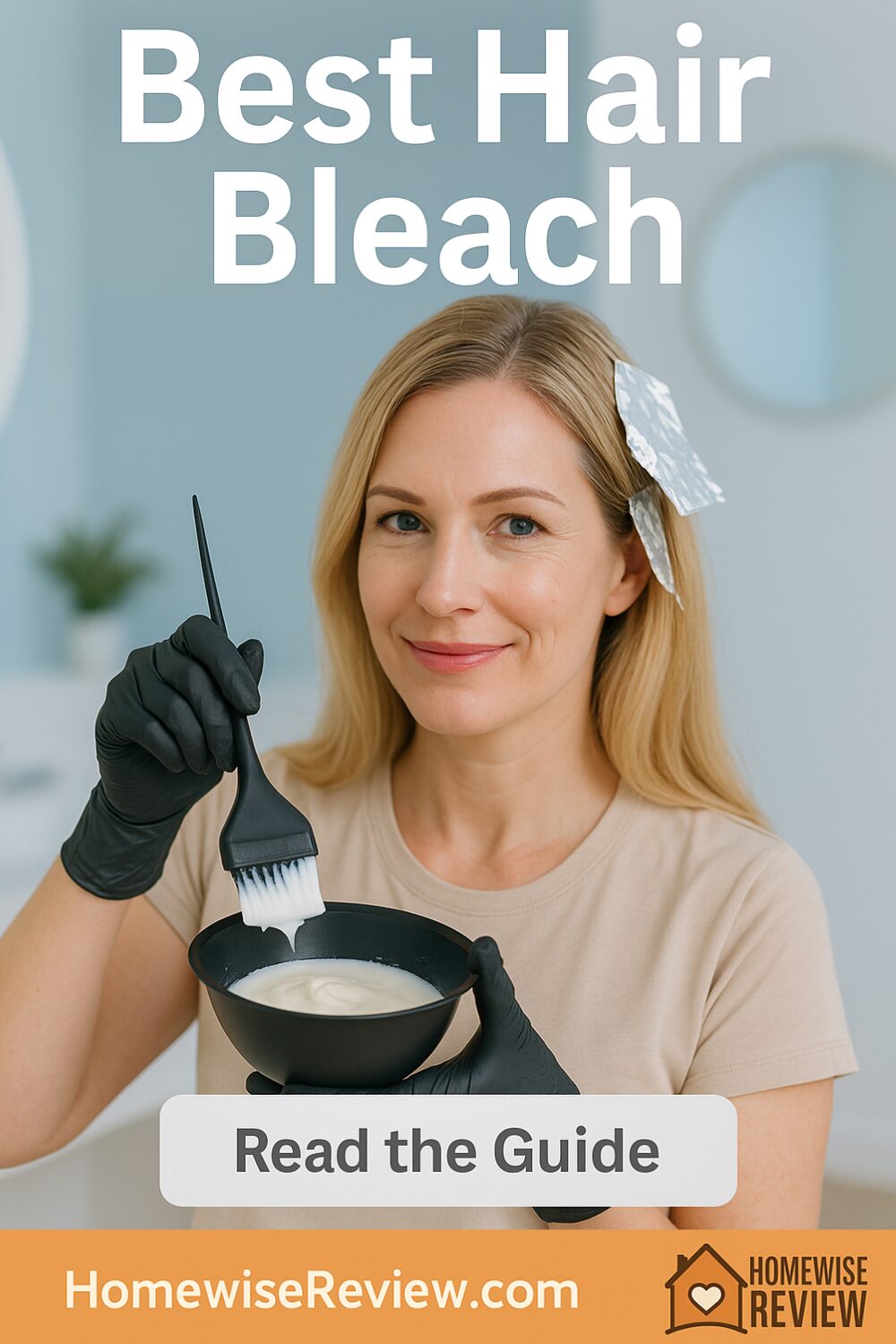
Lightening is chemistry. Good bleach dissolves natural pigment while protecting the hair’s protein structure as much as possible. A smart at-home kit balances three things: a reliable powder or cream lightener, the right developer strength for your starting level and goal, and bond care so strands stay flexible. Your aim is controlled lift, not a race. For most brunettes to dark blondes, that means 20–30 volume developer in small, timed passes with strand tests, not jumping straight to 40. This guide narrows the field to four pro-trusted options that cover fast lift, built-in bond care, on-scalp gentleness, and freehand/balayage control. You’ll also get a simple workflow that reduces banding, brass, and breakage.
Quick Picks + Comparison
| Our pick | Best for | Type & highlights | Why we like it |
|---|---|---|---|
| Wella Blondor Multi Blonde Powder Lightener | Consistent, high-lift lightening from levels 3–7 | Blue-violet powder; mixes smoothly; versatile with 20–30 vol | Predictable lift and brass control that plays nicely with toners |
| Redken Flash Lift Bonder Inside | Lift + built-in bond support | Powder with integrated bond-builder | Faster sessions with less extra chemistry to juggle |
| L’Oréal Quick Blue Powder Bleach | Budget-friendly, widely available high lift | Blue powder; thick, clingy mix | Great for foils and global lifts when you need staying power |
| Schwarzkopf BlondMe Clay Lightener | Freehand/balayage with minimal swelling | Clay lightener; stays where you paint | Open-air control and softer edge transitions |
Ratings reflect a summary of owner feedback and stylist commentary.
Deep dives on the picks
Wella Blondor Multi Blonde Powder Lightener
If you want almost “set-and-forget” predictability, Blondor is a workhorse. The blue-violet base helps mute warm exposure as you lift, so you see where you are headed without panic toning every round. It mixes into a creamy, non-gritty paste that spreads evenly for foils or bowl-and-brush applications. Pair with 20 vol for the first pass from levels 6–7, or 20–30 vol for lower levels depending on strand-test results. Keep sections thin, saturate fully, and monitor every 5–7 minutes rather than cranking the developer. Finish with a pH-balanced rinse and a gentle toner once you’ve reached pale yellow or soft orange, depending on your target shade.
Redken Flash Lift Bonder Inside
When you want the insurance of bond support without measuring separate additives, this formula bakes it in. The paste is smooth, clings well in foils, and gives steady, controlled lift that feels friendlier on previously colored mids. It is not magic, so you still need thoughtful sectioning and timing, but many users report hair feeling more elastic at rinse compared with basic powders. Use 20–30 vol based on your strand test. If your ends are already light, apply to mids first, then roots last, so scalp heat does not over-lift the top.
L’Oréal Quick Blue Powder Bleach
A classic for value and availability. Quick Blue mixes thick, which helps it stay put on global lifts and stubborn dark bands. It is punchy, so resist 40 vol unless a pro is supervising. For home use, stick to 20–30 vol and work in small zones so you can apply fast and even. The blue base helps counter warm, but you will still tone. Expect orange to yellow stages if starting from level 4–5; do not chase white in one go. Rinse thoroughly, shampoo gently, and bring the pH down with conditioner before you tone.
Schwarzkopf BlondMe Clay Lightener
Freehand work needs a product that stays where you paint and hardens on the surface so it can process in open air. Clay lighteners like BlondMe give that “shell,” which preserves moisture underneath and produces softer blends around the edges. Ideal for balayage, teasylights, and face-frame pops without foil lines. Use 20–25 vol for control, and keep your sections thin with generous saturation. Because open-air lift is slower, expect multiple sessions if you are starting dark.
What to look for in a bleach (and what to skip)
- Base and texture: Blue/violet powders subtly counter warmth during lift. Cream and clay formulas give better control for scalp or freehand work.
- Developer strength: 20 vol for controlled lift and retouches; 30 vol for darker levels and resistant hair after a strand test. Avoid 40 vol at home.
- Bond support: Either integrated (as in some powders) or added via a separate bond product. It helps keep elasticity but is not a free pass to over-process.
- Mix ratio and spread: You want a creamy, non-runny paste that fully saturates hair. Gritty or thin mixes cause hot spots and banding.
- Skip: Metal bowls/brushes, overlapping onto fragile ends, and multi-hour “cooking.” More time is not more lift once the mix is exhausted.
A safer at-home workflow (step-by-step)
- Strand test first. Mix a tablespoon of your bleach and chosen developer. Apply to a hidden section, time the lift, note result and feel.
- Section cleanly. Four quadrants, thin slices. Start on the darkest, coolest areas first. Save roots for last because scalp heat speeds lift.
- Mix fresh and small. Bleach loses potency over time. Mix in small batches so each section gets lively product.
- Saturate fully. Butter both sides of each slice. Dry pockets cause tiger stripes.
- Check every 5–7 minutes. Re-saturate dry spots. Stop at pale yellow for blonding or soft orange if you plan a caramel/copper glaze.
- Rinse and rebalance. Rinse thoroughly, shampoo gently, then use an acidic conditioner or mask to bring pH down.
- Tone lightly. Choose a sheer toner to cancel leftover warmth, not a heavy opaque color that turns muddy.
- Aftercare. Use bond-building masks 1–2 times weekly, a gentle shampoo, and a heat protectant. Trim dust ends within 2 weeks to prevent splitting.
Hard rules: Do not bleach eyebrows or lashes. Do not use on irritated scalp. Do not exceed the time from your strand test. When in doubt, book a colorist, especially for box dye correction or level jumps of 3+.
Troubleshooting
- Banding (dark stripes): You overlapped inconsistently. Next session, start on the dark bands first with fresh mix. Use foils for even heat.
- Hot roots (too light at scalp): You did roots first. Always do mids/ends, then roots last. Drop developer at roots if needed.
- Orange that will not budge: Hair is at its limit or you need another session later. Do not push time. Tone warm for now and revisit after 2–3 weeks of repair.
- Breakage/elastic hair: Stop chemical work. Rinse cool, blot, apply a bond mask, and air-dry. Schedule a trim and give it a rest cycle.
- Uneven, patchy lift: You under-saturated or mixed too thin. Use a thicker, creamy paste and smaller sections next time.
Final Thoughts
The “best” bleach is the one you can control. Pick a predictable powder for general lift, a built-in bond option if you want fewer moving parts, a thick budget powder for staying power, or a clay lightener for freehand work. Keep developers sane, strand-test everything, and lift in stages. The goal is healthy, even hair that still shines once you tone and style.
See also
Going lighter is only half the job. For smooth styling days, our Best Hair Rollers & Hot Rollers for Soft Waves guide helps you add polish without heavy heat. If your ends feel thirsty post-bleach, How to Use Argan Oil for Hair shows how to seal without greasing roots. When you want a simple maintenance plan, How to Use Hair Oil covers placement and frequency so you avoid buildup. If you are aiming for cool blond maintenance, Best Shampoos for White Hair explains toning washes and cadence. For daily protection, Best Hairspray for Fine Hair can help you set style with lighter resins that do not crunch on sensitized strands.
FAQs
1) Is 40 volume ever OK at home?
Not recommended. 20–30 vol with smart timing and saturation is safer and usually gets you there in stages.
2) Can I bleach already box-dyed hair?
It is risky. Artificial pigment lifts unpredictably and can band. If you must, strand-test and expect multiple sessions or a pro color correction.
3) How long should I leave bleach on?
Only as long as your strand test showed effective lift, typically 20–45 minutes total with checks every 5–7 minutes. More time after exhaustion only damages hair.
4) Do I need a bond builder?
It helps with elasticity and feel, but it does not prevent damage from over-processing. Still use sane developer strengths and timing.
5) Why does my blonde look dull after a week?
High pH and heat roughen the cuticle. Use an acidic conditioner after bleaching, a heat protectant for styling, and a weekly bond or protein-light mask.
Ratings reflect a summary of owner feedback and stylist commentary.
Affiliate Disclosure
If you purchase through links on our site, we may earn a small commission at no extra cost to you.




